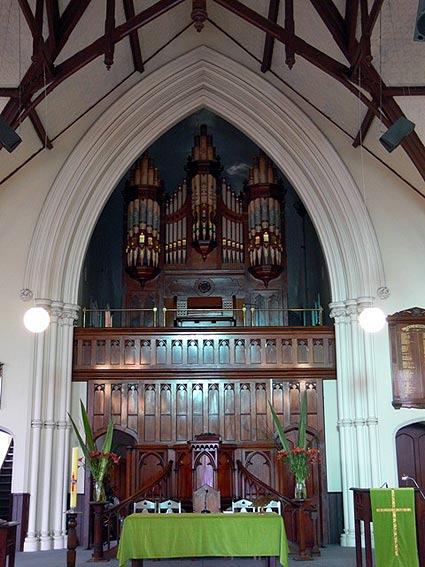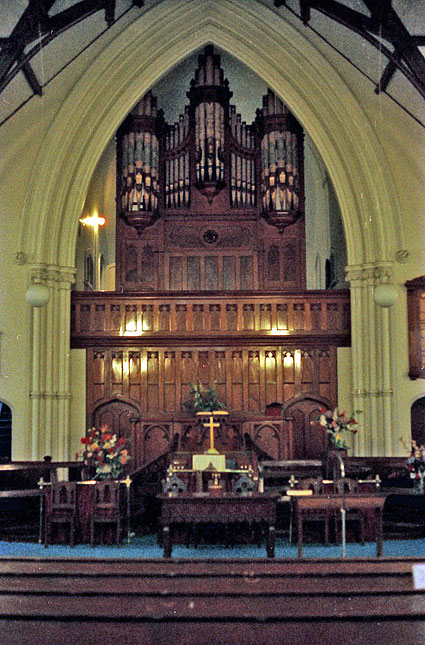South Port Parks Uniting (formerly Presbyterian) Church
Dorcas Street, South Melbourne

The foundation stone of the present church, designed and built by William Ireland, was laid on 1 November 1859 and the building opened on 18 March 1860. Further extensions took place in 1867 and later with the erection of the spacious vaulted apsidal organ chamber with vestries beneath, a drawing and description of which, from the Australasian Builder and Contractors' News appears below:

ARCH AND ORGAN OF PRESBYTERIAN CHURCH, SOUTH MELBOURNE
"Our centre page illustration shows the arrangement of the arch and organ-chamber of the Presbyterian Church in Dorcas-street, South Melbourne, which has lately undergone extensive renovation both within and without. Internally, the most noteworthy improvement is the erection of the fine organ which we show - a work which not only reflects high credit upon those concerned in the execution of it, but says much for the increase of liberal thought and culture in the Presbyterian community since the days when the "king of instruments" was regarded as a "kist o' whistles" (as the old-time Scots called it. The successful and satisfactory arrangement of this portion of the building will speak for itself, and is thoroughly appreciated, as we understand, by the Minister of the Church, the Rev. J. Meiklejohn, M.A., and his congregation. The organ-chamber has been so designed as to assist in bringing out the fine tone and volume of sound of the highly-finished instrument it contains, and to show at its best the happy result of Messrs. Fincham and Hobday's (the organ-builders') labors. The general work has been well carried out by Messrs. Seccull and Abbott, contractors, of Melbourne under Messrs. Garis and Son, architects, of the same city; the total cost of the additions, renovations and organ being about £2,900."
The large two manual organ was built by Fincham & Hobday at a cost of £895 and was opened by G.B. Fentum on 28 June 1891. In 1900, the organ was moved forward to the front of the apse gallery and the console resited at floor level, linked with a long mechanical action. At some stage a Gedact 8ft was substituted for the original Clarionet 8ft. In 1985, George Fincham & Sons replaced the console within the organ case and moved the organ backwards to its original location. The combination action was made entirely pneumatic at this time. A further restoration was carried out in 1996 by S.J. Laurie Pty Ltd. The whole instrument was removed from the church. The work included a complete restoration of the action, windchests, console, double-rise reservoir and casework. New wooden trackers were fitted while a facsimile Clarionet 8ft was inserted in place of the later Gedact. The facade pipes were also restored by Marc Nobel and Christine Holmes; these have elaborate patterns and colours of outstanding richness and variety.

| GREAT Open Dia Loud Gamba Claribel Dulciana Principal Flute Harmonic Twelfth Fifteenth Clarionet Swell to Great SWELL Dou Dia Open Dia Gedact Gamba Celestes Gemshorn Suabe Flute Piccolo Mixture Cornopean Oboe Vox Humana Tremulant PEDAL Open Dia Bourdon Great to Pedal Swell to Pedal |
8 8 8 8 4 4 3 2 8 16 8 8 8 8 4 4 2 3 ranks 8 8 8 16 16 |
1996 gvd bass TC [17.19.22] |
Compass: 58/30
3 composition pedals to Great
3 composition pedals to Swell
lever swell pedal
mechanical key action
tubular-pneumatic stop action
Australasian Builder and Contractors' News, 30 April 1892
E.N. Matthews, Colonial Organs and Organbuilders (Carlton: Melbourne University Press, 1969) p.152
OHTA News, vol 10, no 1 (January 1986), pp. 32-33; vol 21, no 1 (January 1997), p.15
 |
 |
|
 |
 |
|
 |
 |
|
 |
||
Photos: JRM 2006


Photos showing old console on floor before restoration (SC)